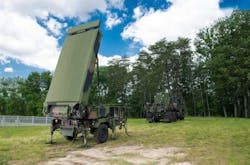Northrop Grumman to build 14 new G/ATOR multi-role radar systems to protect Marines from unmanned aircraft
QUANTICO MARINE BASE, Va. – U.S. Marine Corps surveillance experts are asking Northrop Grumman Corp. to build as many as 14 new mobile land-based radar systems to protect Marines on attack beaches from rockets, artillery, mortars, cruise missiles, unmanned aerial vehicles (UAVs), and other low observables.
Officials of the Marine Corps Systems Command at Quantico Marine Base, Va., announced a $513 million order last month to the Northrop Grumman Corp. Mission Systems segment in Linthicum, Md., for as many as 14 Ground/Air Task Oriented Radar (G/ATOR) systems.
G/ATOR is an expeditionary, three-dimensional, short-to-medium-range, multi-role radar system designed to detect low-observable targets with low radar cross sections such as rockets, artillery, mortars, cruise missiles, and UAVs. Marine Corps leaders are developing and fielding G/ATOR in three blocks for use by the Marine Air Ground Task Force across the range of military operations, officials say.
Northrop Grumman is upgrading G/ATOR by switching the system's gallium arsenide (GaAs) technology to gallium nitride GaN) technology. G/ATOR, which was developed originally with GaAs RF and microwave integrated circuit technology.
Northrop Grumman began converting G/ATOR radar systems from GaAs to GaN technology in 2015 to make the system more effective, and to reduce its costs, and reduce its weight and power consumption.
Substituting gallium nitride electronic components for older gallium arsenide technology will help Northrop Grumman and the Marine Corps reduce the mass of the G/ATOR system without compromising its performance, officials say.
Reducing size, weight, and power consumption (SWaP) especially is important for the G/ATOR system because Marine Corps leaders plan to use the system on attack beaches to help defend Marine expeditionary forces from low-observable threats. The system must be sufficiently small and lightweight to accompany Marines in their initial land attacks.
Northrop Grumman built G/ATOR for short-range air-defense (SHORAD) and tactical air operations Center (TAOC) air surveillance missions, including identification friend-or-foe (IFF). The increment I design was to provide for growth to all following increments without equipment re-design and provide an open architecture to enable upgrades with following increments.
The G/ATOR program was to showcase new component technologies, including the then-new VPX embedded computing fast switch-fabric interconnect. As part of the G/ATOR program's first increment, Northrop Grumman awarded a $4.3 million contract in 2008 to the Curtiss-Wright Corp. Defense Solutions segment in Ashburn, Va., for VPX-based embedded computers for radar signal processing, to be delivered by 2010.
The Ground Weapons Locating Radar (GWLR) portion of G/ATOR uses active electronically scanned array (AESA) radar technology to provide several different radar missions and adapt automatically to changing battlefield conditions.
On this order Northrop Grumman will do the work in Linthicum Heights and Hampstead, Md.; East Syracuse and Rochester, N.Y.; Stafford Springs, Conn.; Tulsa, Okla.; Santa Clarita and San Diego, Calif.; Atlanta; and other locations, and should be finished by October 2028.
For more information contact Northrop Grumman Mission Systems online at www.northropgrumman.com/who-we-are/business-sectors/mission-systems.
